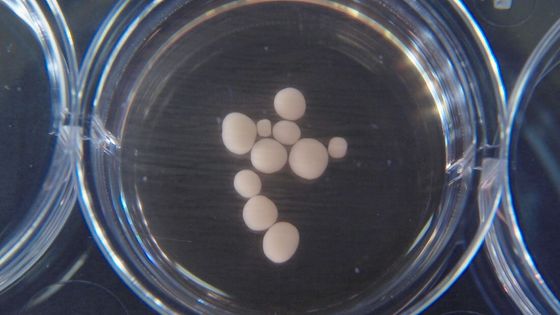A signal resembling a baby's brain wave is detected from a very small brain cultured from skin cells

by
A paper was published that succeeded in detecting brain waves resembling a human fetus from a bean-sized cell tissue cultured from human skin cells.
Complex Oscillatory Waves Emerging from Cortical Organoids Model Early Human Brain Network Development-ScienceDirect
https://www.sciencedirect.com/science/article/abs/pii/S1934590919303376?via%3Dihub
Brain waves detected in mini-brains grown in a dish
https://phys.org/news/2019-08-brain-mini-brains-grown-dish.html
Brain Waves Have Been Detected Coming From 'Mini Brains' Grown in The Lab
https://www.sciencealert.com/brain-tissue-grown-in-the-lab-produces-brainwaves-resemblings-pre-term-babies
Organoids Are Not Brains. How Are They Making Brain Waves?-The New York Times
https://www.nytimes.com/2019/08/29/science/organoids-brain-alysson-muotri.html
Human-like neural activity detected in lab grown mini brains | AFP.com
https://www.afp.com/en/news/15/human-neural-activity-detected-lab-grown-mini-brains-doc-1ju97d1
A team of professors Allison Mutri, who is studying neuroscience at the University of California, San Diego, announced that EEG was detected from cultured cells. Muotori professor is a Kyoto University Center for iPS Cell Research Director Shinya Yamanaka Professor, was carried out at the University of California, San Diego iPS cells to develop research on the human skin cells once stem cells were allowed to change to, brain organoid and Succeeded in creating a cell tissue called.
A brain organoid 10 months after its formation.

Organoids are organs created in vitro, and are characterized by having an anatomical structure that looks exactly like the real one, while being smaller and simpler than the actual organ. The technology to create organoids has developed rapidly since the beginning of the 2010s, but this is the first time that a brain organoid with a neuronal network developed this time has been made in vitro.
Professor Muotori says, “The brain organoids created this time can be used in a variety of fields, from elucidating the mechanisms by which cranial nerves develop, modeling diseases, testing drugs, and even applying to AI technologies.” talked.
The research team also found out that multiple brain organoids were exploding from about two months after generation. Although the brain wave signal is sparse, it is emitted at a certain frequency, which is close to that of a human fetus in the early stages of development. Therefore, the research team trained AI with brain waves recorded from 39 premature babies aged 6 to 9 months and analyzed the neural activity of brain organoids measured with a multi-electrode array.
Multi-electrode array (left) and measurement robot (right) used by the research team

After that, the brain waves of brain organoids were input to AI and the answer was “How many months after the occurrence of the fetus.” The results were consistent with the period during which brain organoids were actually cultured. Professor Muotori talks about this: “It has been suggested that brain organoids follow the same growth process as the human brain.”
On the other hand, brain organoids generated in the laboratory also have a problem that “the growth stops in 9 to 10 months”, and the cause is not well understood. Professor Muotori sees it as 'the problem of
Professor Muotori's research team plans to further improve brain organoids in the future, and research on diseases caused by neural network dysfunction , such as autism , epilepsy, and schizophrenia, and their treatment. It is.

by iLexx
In addition, Prof. Mutri said about the brain waves detected from brain organoids, 'Brain organoids are a very simple model, so it seems to have nothing to do with real brain-like activities,' brain organoids are conscious. He expressed his view that it is unlikely. At the same time, he clarifies his attitude to carefully proceed with his research, recognizing that “as brain organoids become closer to the real brain, it is inevitable that all ethical doubts will erupt”.
Related Posts:
in Science, Posted by log1l_ks







